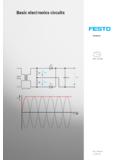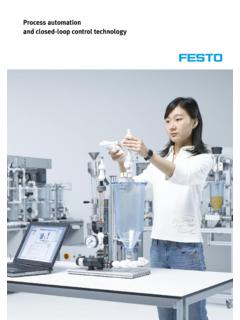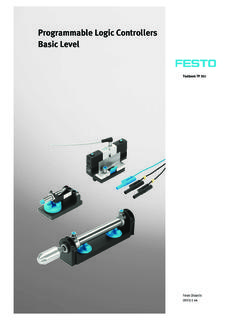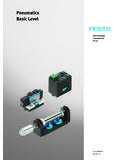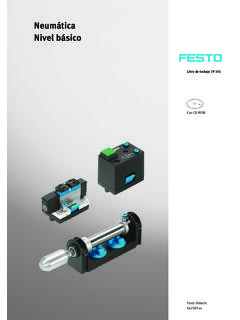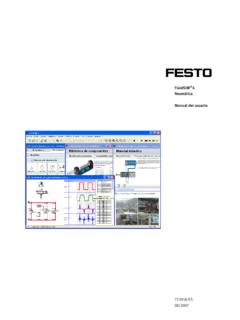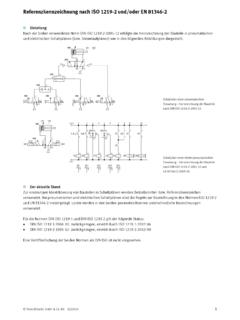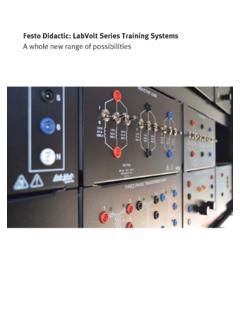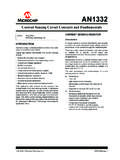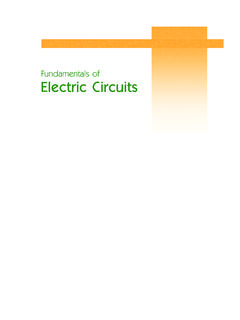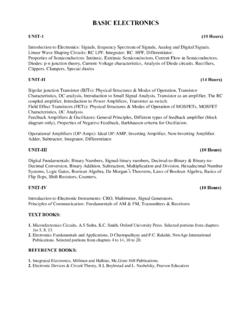Transcription of Pneumatics Basic Level - Festo Didactic
1 Textbook TP 101 Festo Didactic093131 enPneumaticsBasic 09:13:24 Order no.: 093131 Description: Designation: Edition: 10/2002 Layout: B. Huber Graphics: D. Schwarzenberger, T. Ocker Author: P. Croser, F. Ebel Copyright by Festo Didactic GmbH & Co., 73770 Denkendorf 2002 The copying, distribution and utilization of this document as well as the communication of its contents to others without expressed authorization is prohibited. Offenders will be held liable for the payment of damages. All rights reserved, in particular the right to carry out patent, utility model or ornamental design registrations. Festo Didactic TP101 3 Contents Notes on the layout of the 8 Section A: Course Chapter 1 Characteristics and applications of 11 Pneumatics in 12 Pneumatics and control system development.
2 18 Structure and signal flow of pneumatic 19 Chapter 2 Components of a pneumatic 23 Air generation and distribution .. 24 Valves .. 27 Processing elements (processors).. 33 Power components .. 34 Systems .. 35 Chapter 3 Symbols and standards in 39 Symbols and descriptions of components .. 40 Safety requirements for pneumatic 51 TP101 Festo Didactic 4 Contents Chapter 4 Methods for the development of pneumatic Development of pneumatic Control chain ..57 Design of the circuit Circuit Designation of individual The life cycle of a pneumatic Chapter 5 Development of single actuator Direct control of a pneumatic cylinder.
3 68 Example 1: Direct control of a single-acting Exercise 1: Direct control of a double-acting Indirect control of a pneumatic Example 2: Indirect control of a single-acting cylinder ..72 Exercise 2: Indirect control of a double-acting cylinder ..74 Logic functions: AND, Example 3: The logic AND Exercise 3: The logic AND Example 4: The logic OR Exercise 4: The logic OR function ..83 Example 5: Memory circuit and speed control of a cylinder ..85 Exercise 5: Memory circuit and speed control of a cylinder ..88 Exercise 6: The quick exhaust valve ..90 Example 6: Pressure dependent control ..92 Exercise 7: Pressure dependent Example 7: The time delay Exercise 8: The time delay Festo Didactic TP101 5 Contents Chapter 6 Development of multiple actuator 101 Control of multiple actuators.
4 102 Example 8: Co-ordinated motion .. 102 Example 9: Signal overlap .. 107 Signal elimination by reversing 109 Example 10: Reversing valve .. 109 Example 11: Reversing 112 Chapter 7 Trouble-shooting of pneumatic 115 116 The causes and effects of 116 Maintenance .. 120 Section B: Theory Chapter 1 Fundamentals of 123 Physical 124 Characteristics of air .. 126 Chapter 2 Air generation and 129 Air preparation .. 130 Air 131 134 Air 136 Air distribution .. 141 Service unit .. 144 TP101 Festo Didactic 6 Contents Chapter 3 Actuators and output Single-acting Double-acting cylinders.
5 158 Rodless cylinders ..164 Cylinder Cylinder performance characteristics ..170 Chapter 4 Directional control Configuration and 2/2-way 3/2-way 4/2-way 4/3-way 5/2-way 5/3-way Flow values of valves ..201 Reliable operation of valves ..202 Chapter 5 Non-return, flow and pressure valves, valve Non-return valves ..204 Flow control Pressure Combinational valves ..218 Festo Didactic TP101 7 Contents Chapter 6 223 Selection and comparison of working and control 224 Control theory .. 227 Control system development .. 231 Development aspects .. 240 Modern pneumatic 241 Section C: Solutions 245 List of 264 List of 265 267 Physical values and 274 TP101 Festo Didactic 8 Contents Notes on the layout of the book This textbook forms part of the Learning System for Automation and Technology from Festo Didactic GmbH & Co.
6 It has been designed for training courses and is also suitable for the purpose of self-tuition. The book is divided into the following sections : Part A: Course section, Part B: Theory section, Part C: Solutions to the exercises. Part A: Course The course provides the necessary information on the subject con-cerned using both examples and exercises, and is to be worked through in sequence. Subjects which are dealt with in greater depth in the The-ory section are marked in the text. Part B: Theory This section contains detailed information on fundamentals. Topics are set out in a logical manner. The student can either work through this section chapter by chapter or use it for reference purposes.
7 Part C: Solutions This section contains the solutions to the exercises in Part A. A comprehensive index is provided at the end of the textbook. The concept of this textbook supports training in key qualifications in the newly structured engineering and electro-technical vocations. Particular value is attached to the fact that students have the option of learning the subject concerned by working through the course section independently. The book can be incorporated into an existing training program. Festo Didactic TP101 9 Section A Section A Course TP101 Festo Didactic 10 Section A Festo Didactic TP101 11 Chapter A-1 Chapter 1 Characteristics and applications of Pneumatics TP101 Festo Didactic 12 Chapter A-1 Pneumatics in review Pneumatics has long since played an important role as a technology in the performance of mechanical work.
8 It is also used in the development of automation solutions. In the majority of applications compressed air is used for one or more of the following functions: To determine the status of processors (sensors) Information processing (processors) Switching of actuators by means of final control elements Carrying out work (actuators) To be able to control machinery and installations necessitates the con-struction of a generally complex logic interconnection of statuses and switching conditions. This occurs as a result of the interaction of sen-sors, processors, control elements and actuators in pneumatic or partly pneumatic systems. The technological progress made in material, design and production processes has further improved the quality and diversity of pneumatic components and thereby contributed to their widely spread use in auto-mation.
9 The pneumatic cylinder has a significant role as a linear drive unit, due to its relatively low cost, ease of installation, simple and robust construction and ready availability in various sizes and stroke lengths. The pneumatic cylinder has the following general characteristics: Diameters to 320 mm Stroke lengths 1 to 2000 mm Available forces 2 to 45000 N at 6 bar Piston speed to m/s Festo Didactic TP101 13 Chapter A-1 Pneumatic components can perform the following types of motion: Linear Swivel Rotary Some industrial applications employing Pneumatics are listed below: General methods of material handling: Clamping Shifting Positioning Orienting Branching of material flow General applications.
10 Packaging Filling Metering Locking Driving of axes Door or chute control Transfer of materials Turning and inverting of parts Sorting of parts Stacking of components Stamping and embossing of components Fig. Single-acting cylinder TP101 Festo Didactic 14 Chapter A-1 Pneumatics is used in carrying out machining and working operations. For example: Drilling Turning Milling Sawing Finishing Forming Quality control Fig. Points switch for two conveyor belts Fig. Pneumatic cutter Festo Didactic TP101 15 Chapter A-1 Advantages and distinguishing characteristics of compressed air: Availability Air is available practically everywhere in unlimited quantities.
